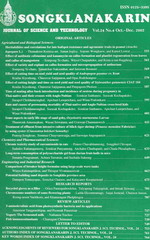ThaiScience
ThaiScience
SONGKLANAKARIN JOURNAL OF SCIENCE & TECHNOLOGY
Volume 41, No. 05, Month SEPTEMBER, Year 2019, Pages 1093 - 1100
Growth performance and production cost of laboratory-scale marine microalgae culture using a light-emitting diode
Wasana Arkronrat and Vutthichai Oniam
Abstract Download PDF
The effects of a light-emitting diode (LED) were examined and compared to fluorescent light on the growth performance of four marine microalgae, Nannochloropsis oculata, Tetraselmis suecica, Chaetoceros calcitrans, and Thalassiosira weissflogii cultured under laboratory conditions for 240 h (10 days). The results showed that the cell densities of N. oculata cultured using fluorescent lamps (T1) and cool daylight LED (T2) were higher than warm white LED (T3), and the growth rate of this species using T2 were higher than for T1 and T3. The cell density of the T. suecica culture in each treatment was not different, but the growth rate using T1 was higher than for T3. The cell densities and growth rates of C. calcitrans and T. weissflogii culture in each treatment were not different. In addition, commercial Chaetoceros produced using cool daylight LED illumination had a lower production cost compared with production using cool white fluorescent illumination. Therefore, commercial laboratory-scale production of marine microalgae should use a cool daylight LED as the light source in order to reduce the production cost without affecting the growth and quality of microalgae.
Keywords
microalgae, light-emitting diode (LED), growth performance, production costSONGKLANAKARIN JOURNAL OF SCIENCE & TECHNOLOGY
Published by : Prince of Songkla University
Contributions welcome at : http://rdo.psu.ac.th
